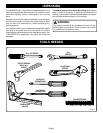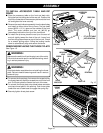
Page 13
Fig. 6
FEATURES
WARNING:
Although some of the illustrations in this manual are
shown with the blade guard removed for clarity, do not
operate the saw without the blade guard unless specifically
instructed to do so.
OPERATING COMPONENTS
The upper portion of the blade projects up through the table,
surrounded by an insert called the throat plate. To cut wood
at a bevel, the blade must be tilted, using the blade adjust-
ment handle, scale, and bevel indicator found on the front of
the cabinet. Inside the cabinet, adjustable positive stops are
provided for 0º and 45º.
The sliding miter table assembly is used for all crosscutting
operations. The miter fence is easily adjusted to cut wood at
an angle by loosening the adjusting clamp, setting the fence
to the miter scale, and retightening the clamp. The sliding
miter table, which rests on a base mounted on the rails, can
be repositioned along the rails for wide work. It can be
reversed so the projecting base is in the back. It can also be
moved from the right side to the left side as needed. With the
miter fence removed the miter table offers additional support
for other operations such as ripping.
Your saw includes a rip fence and an accessory table. The
accessory table can be moved from the right side of the saw
to the left side as needed. The rip fence is used to position
work that will be cut lengthwise. A scale on the front rail
shows the distance between the rip fence and the blade.
The riving knife is a metal device directly behind and above
the blade. It is used to help keep the cut wood from binding
together and causing possible kickback. It is very important
to use the riving knife for all through-sawing operations. The
anti-kickback pawls are toothed plates mounted on the riving
knife. Their teeth point away from the work in case the work
should be pulled back, toward the operator. Then the teeth
dig into the wood to help prevent or reduce the possibility of
kickback.
Your Ryobi BT3100-1 table saw features a receptacle on the
right side of the cabinet that permits use of accessories. Use
only accessories that are listed for use with this tool. When
using a listed accessory, unplug the saw motor cord and use
the receptacle and BT3100-1 main power switch to operate
the accessory.
POWER SWITCH
Your table saw is equipped with a power switch that has a
built-in locking feature. This feature is intended to prevent
unauthorized and possible hazardous use by children and
others.
TO TURN YOUR SAW ON:
1. With the switch key inserted into the switch, lift the switch
button to turn on ( ).
TO TURN YOUR SAW OFF:
1. Press the switch button down to turn off ( ).
TO LOCK YOUR SAW :
1. Press the switch button down.
2. Remove the switch key from the switch and store in a safe,
secure location.
WARNING:
Always remove the switch key when the tool is not in use
and keep it in a safe place. In the event of a power failure,
turn the switch off ( ) and remove the key. This action
will prevent the tool from accidentally starting when power
returns.
WARNING:
ALWAYS make sure your workpiece is not in contact with
the blade before operating the switch to start the tool.
Failure to heed this warning may cause the workpiece to
be kicked back toward the operator and result in serious
personal injury.
WARNING:
To reduce the risk of accidental starting, ALWAYS make
sure the switch is in the off ( ) position before plugging
tool into the power source .
SWITCH
KEY
SWITCH IN LOCKED POSITION
SWITCH
BUTTON
IN OFF
POSITION
SWITCH
BUTTON
IN ON
POSITION


















